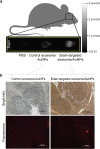Surface modification of gold nanoparticles with neuron-targeted exosome for enhanced blood-brain barrier penetration
- PMID: 31164665
- PMCID: PMC6547645
- DOI: 10.1038/s41598-019-44569-6
Surface modification of gold nanoparticles with neuron-targeted exosome for enhanced blood-brain barrier penetration
Abstract
Gold nanoparticles (AuNPs) have been extensively used as nanomaterials for theranostic applications due to their multifunctional characteristics in therapeutics, imaging, and surface modification. In this study, the unique functionalities of exosome-derived membranes were combined with synthetic AuNPs for targeted delivery to brain cells. Here, we report the surface modification of AuNPs with brain-targeted exosomes derived from genetically engineered mammalian cells by using the mechanical method or extrusion to create these novel nanomaterials. The unique targeting properties of the AuNPs after fabrication with the brain-targeted exosomes was demonstrated by their binding to brain cells under laminar flow conditions as well as their enhanced transport across the blood brain barrier. In a further demonstration of their ability to target brain cells, in vivo bioluminescence imaging revealed that targeted-exosome coated AuNPs accumulated in the mouse brain after intravenous injection. The surface modification of synthetic AuNPs with the brain-targeted exosome demonstrated in this work represents a highly novel and effective strategy to provide efficient brain targeting and shows promise for the future in using modified AuNPs to penetrate the brain.
Conflict of interest statement
The authors declare no competing interests.
Figures




References
-
- Safari J, Zarnegar Z. Advanced drug delivery systems: Nanotechnology of health design A review. Journal of Saudi Chemical Society. 2014;18:85–99. doi: 10.1016/j.jscs.2012.12.009. - DOI
-
- Ajnai G, et al. Trends of gold nanoparticle-based drug delivery system in cancer therapy. Journal of Experimental & Clinical Medicine. 2014;6:172–178. doi: 10.1016/j.jecm.2014.10.015. - DOI
-
- Gao, Y. & Li, Y. In Advances inNanotheranostics I 53–101 (Springer, 2016).
Publication types
MeSH terms
Substances
LinkOut - more resources
Full Text Sources

